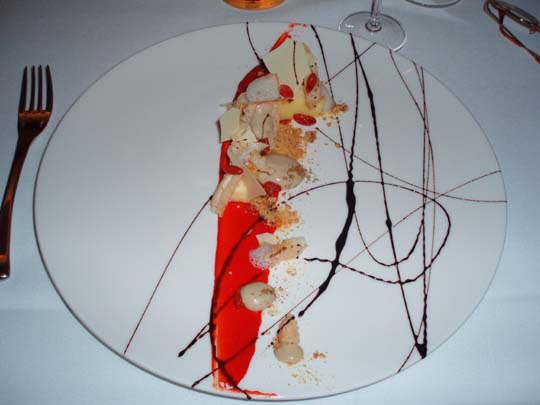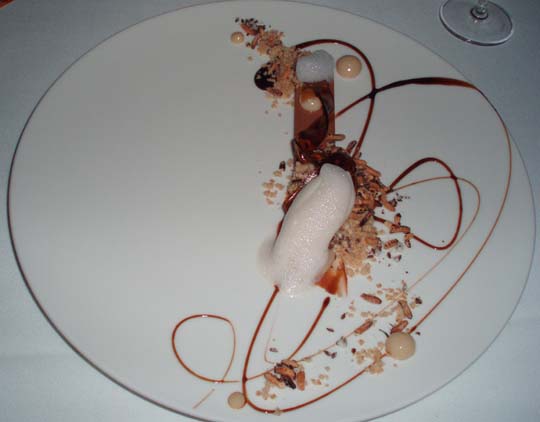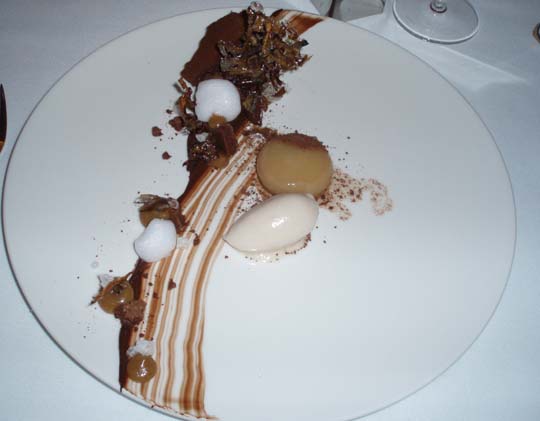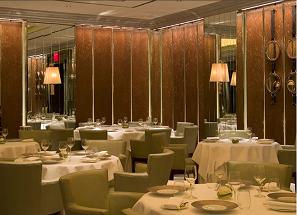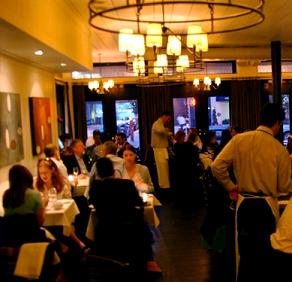 I haven’t had the best luck with restaurant visits on holidays, such as New Year’s Eve. Restaurants tend to simplify and reduce the scope of their menus, while charging more—in some cases a ton more—than they normally would. Our dinner last year at Picholine was a particularly egregious example of this: $800 for two, for a menu that wasn’t worth half that.
I haven’t had the best luck with restaurant visits on holidays, such as New Year’s Eve. Restaurants tend to simplify and reduce the scope of their menus, while charging more—in some cases a ton more—than they normally would. Our dinner last year at Picholine was a particularly egregious example of this: $800 for two, for a menu that wasn’t worth half that.
Perhaps the common-sense solution this year would have been to stay home, and save the blow-out meal for another evening. But I reasoned there must be a New Year’s Eve dinner in New York that isn’t a rip-off, and I was determined to find it. At WD-50, we hit pay dirt. It was my first holiday meal at a fine dining restaurant that was worth every penny. I reasoned that the eccentric avant-garde chef Wylie Dufresne wouldn’t suddenly start serving airline food just because he has a captive holiday audience. Dufresne did not disappoint.
At WD-50, the nine-course tasting menu normally sells for $105 [since increased to $125]. I don’t mind a reasonable premium, and the cost on New Year’s Eve was $145. That included a champagne toast, and a free disposable camera and party favors on every table, so the price was fairly close to what you’d pay anyway. The optional wine pairings were $85, again a reasonable cost for 9 half-glasses apiece.
This was the menu, with wine pairings shown in italics:
Crispy carmelized cauliflower, bone marrow, wild American caviar
Cava, Avinyo Brut, NV (Penedes, Spain)
Oyster, salsify, fried lentils, kimchee puree
Cava, Avinyo Brut, NV (Penedes, Spain)
Foie gras in the round
Viognier “Sanford and Benedict” Cold Heaven 2005 (Santa Barbara, CA)
Smoked eel, blood orange “zest,” black radish, chicken skin
Pouilly-Fuisse “La Croix” VV Robert-Denogent 2004 (Burgundy, France)
Melted cheddar, black truffle, crispy potato, powdered toast
Pink Wine Pax 2005 (Sonoma, CA)
Mediterranean bass, edamame-rye bread, chive mashed
Valpolicella Classico Superiore TB Bussola 2003 (Veneto, Italy)
Lamb loin, cucumber, pickled tongue, spicy pear, sorrel
Shiraz “Lloyd Reserve” Coriale Vinyards 2001 (McLaren Vale, South Australia)
Banana puree, hazelnut, coffee, parsnip
Commanderia St. John NV (Lemesos, Cyprus)
“Creamsicle,” rooibos, squash, orange blossom
Commanderia St. John NV (Lemesos, Cyprus)
Mango jelly-mastic; Milk chocolate-menthol
Champagne toast
Guy Charlemagne Rose Brut NV (Champagne, France)
Many of the dishes are really indescribable. Dufresne and pastry chef Alex Stupak create combinations of ingredients that you’d never imagine together. How, for instance, does one think of smoked eel, blood orange, black radish, and chicken skin? Just to ask the question is to realize how bizarre it is. And how successful. My friend, who said she normally hates eel, loved this dish.
“Foie gras in the round” was another really odd concoction. Somehow, Dufresne managed to produce little pellets of foie gras, each about half the size of a small pea. Incredulous, we asked the server how it was done. He replied that it’s a trade secret, but it involves liquefying foie gras and combining it with another liquid, an explanation that only adds to the mystery.
Each dish is rather small, and sometimes an ingredient is just a dash of crumbs, such as the powdered toast that came with the melted cheddar, or the light dusting of ground coffee that came with the banana puree. Dufresne’s gimmickry does not stand in the way of good solid cooking. The Mediterranean bass was impeccably prepared, as was the lamb loin.
With so many wacky experiments on the menu, not all could be hits. The gooey oyster (our second course) was dull and not very appetizing. But that was really the only course that I could have done without.
The restaurant was full, and service was a bit variable. Several times we were served food before the associated wine pairing arrived. When I asked our server to slow down the parade of courses, he replied, “Sorry, I don’t control the kitchen.” Our reservation was at 9:00, and we didn’t leave till past midnight, so I wouldn’t say we were pushed out the door. Still, it wasn’t an acceptable answer at a restaurant of WD-50’s calibre.
WD-50 is one of the more casual fine-dining restaurants in town, although on the Lower East Side it’s hard to imagine anything more formal. There were guests in sport coats and fancy dresses, and there were guests in t-shirts and jeans. Most were on the young side, although one table was taken by two older ladies.
In 2003, William Grimes of the Times awarded two stars to WD-50, noting Dufresne’s undeniable talent, but also that “diners are more likely to respond with respect than love.” Three years into the experiment, Dufresne is as sure of his palate as an adoring public is sure of him. This was my second visit to WD-50, so I’m fairly confident that this New Year’s Eve performance was no fluke. WD-50 isn’t for everyone, but for those open-minded souls willing to to think broadly, it’s as good a restaurant as there is.
[Update: In March 2007, Frank Bruni of The Times upgraded WD-50 to three stars.]
WD-50 (50 Clinton Street between Stanton and Rivington Streets, Lower East Side)
Food: ***½
Service: **
Ambiance: **
Overall: ***
 Friday, January 12, 2007 at 02:26PM
Friday, January 12, 2007 at 02:26PM  La Vineria is an unassuming trattoria that one could easily overlook, on a stretch of West 55th Street dominated by much larger places—indeed, despite knowing the address, I walked right by it the first time. Once inside, you quickly forget you’re in Midtown. The space is cozy, with the décor dominated by an exposed kitchen and a high shelf lined with old wine bottles that encircles the room.
La Vineria is an unassuming trattoria that one could easily overlook, on a stretch of West 55th Street dominated by much larger places—indeed, despite knowing the address, I walked right by it the first time. Once inside, you quickly forget you’re in Midtown. The space is cozy, with the décor dominated by an exposed kitchen and a high shelf lined with old wine bottles that encircles the room.



